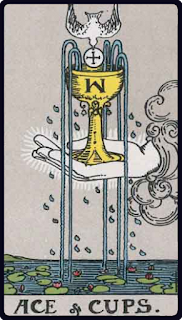
Representing beginnings; the Ace of Cups is associated with the formation of new relationships and connections, these can be entirely novel or they can be existing relationships that had long been dormant, extant, or thought of as extinguished entirely.
In the upright state the Ace of Cups portends a new meeting of hearts, a new emotional connection to be formed. This new connection will have opportunities for growth but also bring with it a transformation and a change of outlook. The relationships this card portends to are not fleeting, they will endure for some time, perhaps a lifetime or perhaps only for a season, in any case they will endure for longer than one meeting, they represent someone or something that is going to be involved with our life going forward.
In the inverted state the Ace of Cups portends the renewal of a long dormant relationship, or the slate of an existing relationship being wiped clean and both sides agreeing to start over this could be the result of conflict resolution, or revelations that have fundamentally changed the nature of your relationship necessitating a return to square one.
It is important to note here that relationships in the Tarot always have 2 components, the first is our conscious mind which represents our side of the relationship, and the second is the other element. This element can be singular, in the form of another person, object, or concept; where this other is introspective, it represents our inner self, the unconscious, and how we treat ourselves. This other element can also be plural; however, it still takes as a collective all other individuals as one component. For example, a teacher being met with a new class of students could be depicted by the Ace of Cups representing a one-to-many relationship forming.
In the Rider-Waite deck the Ace of Cups is depicted as a golden chalice with an inverted M on its side. This chalice represents the Virgin Mary. The chalice serves to represent her womb, with the Holy Spirit in the form of a dove descending into the chalice representing the immaculate conception.
In the centre of the chalice a Sun Cross can be seen held in the mouth of the Holy Spirit, this symbol represents the Earth in circular form, with the cross representing the four rivers of Eden, the Euphrates, Tigris, Gihon, and Pishon, together these flow into the chalice representing the gift of life. From the chalice 5 streams of water then flow outward, the first 4 representing the 4 rivers of Eden, and the 5th representing the tears of the Virgin Mother who would come to lose her son as sacrifice to absolve humanity of its sins.
In an original or faithful reproduction of the Rider-Waite deck, when the Ace of Cups is inverted, above the M there is an inscription, although hard to read this text is written in cursive Hebrew and loosely translates as “Levant” the geographical region described by the Book of Genesis as the location of Eden. Reproductions of the deck lack this detail replacing it with a pattern around the stem of the chalice. Other Tarot decks inspired by the Rider-Waite deck retain the inscription more clearly visible. Finally, the chalice itself is held in the hand of God which emerges from a cloud to the right depicting this act of giving.
In self-reflection the Ace of Cups serves as a prompt to consider what opportunities exist to establish a relationship, or to rekindle one that has not been given the attention that it should have been.
The focus here is placed on nurturing an existing potential for connection. This tends to be someone you are already aware of and not someone completely unknown to you, even if you have no existing relationship with them, you are already aware of each other.
The emphasis is placed on recognising the potential for growth that already exists. It is unrealistic to imagine every friend you make will become the closest friend you have ever had, or that every potential love interest will be the love of your life. The importance of nurturing relationships without expectation is your focus here.
Ask yourself “Could we be closer?” or “Should I try and get to know them better?” recognise that the younger we are, the easier it is to form connections with others because life at a young age puts us in situations where we meet others for example through school, college, and University. As we grow older, we are put together with others less and less it becomes our own responsibility and our own effort that creates these opportunities.
By developing existing relationships and forming connections with people you are already aware of you create the opportunity to connect with a wider circle of people. Reflect on the people you have met in life to date, those that you have been closest to, and how you first met. Who or what was responsible for putting you in the same place to experience that opportunity for connection?

No comments:
Post a Comment
All comments are moderated before they are published. If you want your comment to remain private please state that clearly.